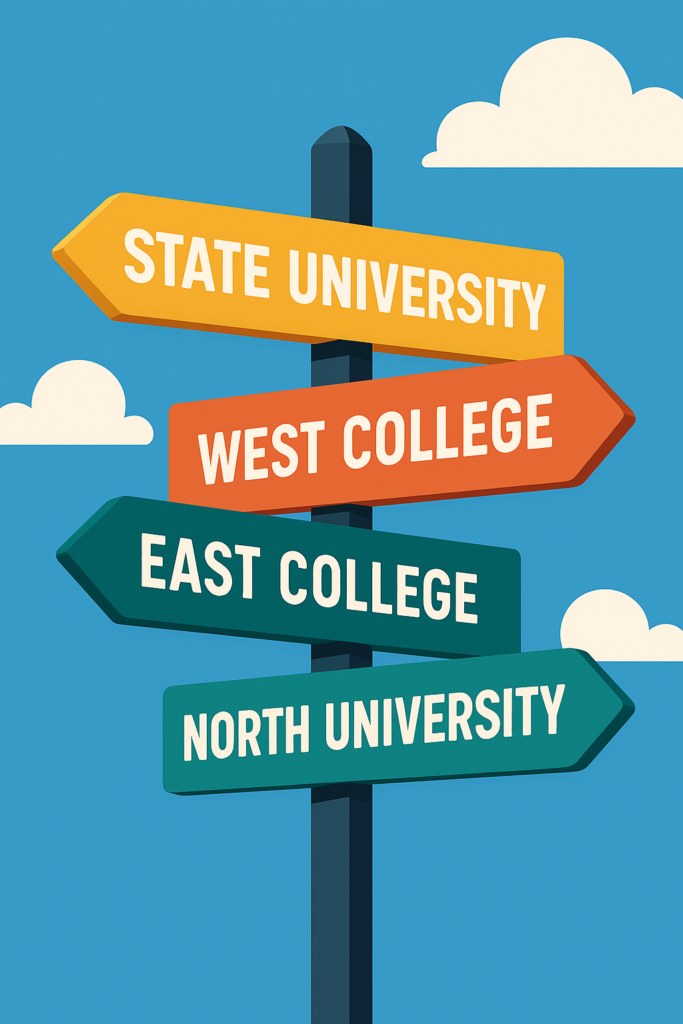In my last post, I talked about how prestige is often just an illusion—especially when it comes to college choice. We know the highest-ranked school on a list isn’t necessarily the best fit for every student. But if students are going to take ownership of their college process, they need tools and frameworks to actually figure out what a good fit looks like for them.
This post is all about giving counselors practical strategies to help their students identify their own best-fit schools. This isn’t just about matching them to colleges; it’s about empowering them to think critically and prioritize what matters most.
Why Fit Matters More Than Prestige
As we discussed last time, words like “prestige” can be deceptive. Even Frank Bruni’s Where You Go Is Not Who You’ll Be highlights that the most successful people don’t necessarily come from “brand name” schools. Instead, their success is driven by factors like mentorship, engagement, and opportunities to grow—elements students are more likely to find when their college choice is a genuine fit.
Helping students define their own college fit requires breaking away from the mindset that certain schools are inherently better. Instead, it’s about shifting the conversation to what the student actually wants and needs.
Strategies for Helping Students Define Fit
- College Fit Worksheet
Encourage students to fill out a College Fit Worksheet. This exercise breaks down factors like size, location, academic programs, extracurriculars, cost, and campus culture. By ranking their priorities, students start to gain clarity about what they truly want. You can download my College Fit Worksheet. - Guided Reflection Questions
Prompt students to ask themselves questions like:
- What environments have I thrived in before?
- What kind of community am I looking for?
- What do I need to feel challenged and supported?
- Encouraging students to reflect on their values, interests, and goals before diving into the college search is so important. This approach can be facilitated by a book I mentioned in my last post: Steven Antonoff’s College Match, which emphasizes self-discovery as the foundation of a successful college search. College Match helps students identify their values, interests, and goals before they even start building their lists, allowing them to create a more intentional and personalized college selection process. Imagine a workbook but all of the activities are to help them determine the right college for them, I highly recommend a few copies in your office.
- Rankings aren’t inherently bad, but we have to understand their content, motives, and the criteria used to rank them. It’s all about context and knowing how to evaluate them for what they are—tools, not verdicts. I try to get students to approach rankings with a critical eye, understanding that the most important factor is fit, not fame.
- Another well-known Steven Antonoff book that employs a “ranking” system that I enjoy sharing with families is The College Finder, which is soon to be re-released and coauthored by a high school counselor/friend from Atlanta. The College Finder is essentially a comprehensive directory of colleges organized by specific characteristics, interests, and qualities that students might be looking for. Whether it’s colleges with strong writing programs, schools known for hands-on learning, or institutions that prioritize internships and career development, this book offers a great way for students to start building a list that fits their criteria.
- Additionally, Colleges That Change Lives by Loren Pope is another fantastic resource that I’ve found helpful for guiding students toward finding the right fit. Pope’s book profiles 40 small, less-selective colleges that emphasize personal growth, mentorship, and unique educational experiences. This list can be a breath of fresh air for students who feel pressured by prestige, providing them with concrete examples of schools where fit truly matters and where they can thrive. Even if they don’t apply to one of the CTCL schools, it may expose them to other qualities of their “perfect” college/university.
- Instead of starting with a college’s reputation or ranking, I like to help students start with themselves. When students take ownership of their process by digging into what matters most to them, their lists are more thoughtful, balanced, and likely to lead to a positive college experience.
- Research Beyond Rankings
College rankings can be helpful for identifying certain characteristics, but they shouldn’t be the sole factor guiding a student’s choices. Encourage students to dig deeper by reading student testimonials, visiting campuses (virtually or in person), and sitting-in on classes. Jeff Selingo’s Who Gets In and Why provides a detailed look at how colleges themselves often value different attributes than what rankings might suggest. - Encourage Open-Mindedness
Remind students that many of the most transformative college experiences come from schools they hadn’t even considered at first. Bruni’s book is full of stories about students who found their perfect fit in unexpected places. Share similar success stories from your own students to help illustrate this point. - Reframe the College List Process
Instead of starting with a list of “prestigious” schools and narrowing down, encourage students to build a list based on their personal criteria. This is another area where Antonoff’s exercises can be especially useful (both of his books, really). Once students have identified their priorities, they can filter schools based on those criteria—rather than prestige or name recognition.
Tools & Resources for Counselors
As counselors, we often have to balance helping students find their best fit with managing all other responsibilities. Here are some resources you can share with your students:
- Here is a basic worksheet
- College Board’s BigFuture – A fantastic tool for researching colleges and identifying potential fits.
- NACAC’s College Fit Worksheet – Another useful resource for guiding students in their college search.
- FAFSA Checklist – Financial fit is just as important as academic or social fit.
Final Thoughts
Helping students find their best-fit colleges isn’t about steering them toward certain schools. It’s about giving them the tools and framework to figure it out themselves. As counselors, we’re here to help them think critically, advocate for their needs, and ultimately build a list that reflects who they are—not just where they think they’re supposed to go.

